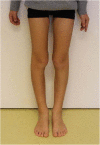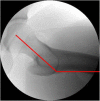Femoral Derotational Osteotomies
- PMID: 29696606
- PMCID: PMC5970118
- DOI: 10.1007/s12178-018-9483-2
Femoral Derotational Osteotomies
Abstract
Purpose of review: Femoral derotational osteotomies are performed to correct residual symptomatic increased femoral torsion in adolescents and adults. Typical indications are anterior knee pain caused by patellar maltracking and patellofemoral instability. There is still no consensus as to what the correct indication is and which surgical techniques lead to the best outcomes in performing a femoral derotational osteotomy.
Recent findings: Good early clinical outcomes have been reported. However, long-term studies and data on return to play are lacking. Surgery often is performed according to the surgeon's experience. There is no evidence to support decisions regarding surgical technique or level of osteotomy. Femoral derotational osteotomy is the treatment of choice in patients with symptomatic excessive anteversion and torsional malalignment of the femur. Multiple techniques have shown good clinical results with high patient satisfaction. Future studies however must focus on radiographic and clinical assessment to understand different subtypes of torsional deformity and its implication on operative therapy.
Keywords: Femoral anteversion; Femoral derotational osteotomy; Hip pain; Intoeing; Knee pain; Patellofemoral instability.
Conflict of interest statement
Conflict of interest
Manfred Nelitz declares that he has no conflict of interest.
Human and animal rights and informed consent
This article does not contain any studies with human or animal subjects performed by any of the authors.
Figures






References
-
- Kling TF, Jr, Hensinger RN. Angular and torsional deformities of the lower limbs in children. Clin Orthop Relat Res. 1983;176:136–147. - PubMed
Publication types
LinkOut - more resources
Full Text Sources
Other Literature Sources
Research Materials

